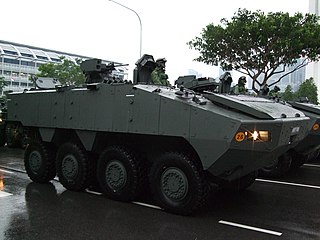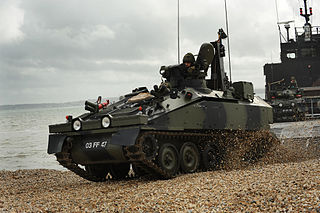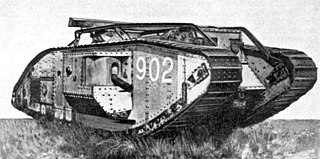
A military engineering vehicle is a vehicle built for construction work or for the transportation of combat engineers on the battlefield. These vehicles may be modified civilian equipment or purpose-built military vehicles. The first appearance of such vehicles coincided with the appearance of the first tanks, these vehicles were modified Mark V tanks for bridging and mine clearance. Modern military engineering vehicles are expected to fulfill numerous roles, as such they undertake numerous forms, examples of roles include; bulldozers, cranes, graders, excavators, dump trucks, breaching vehicles, bridging vehicles, military ferries, amphibious crossing vehicles, and combat engineer section carriers.

The FV4034 Challenger 2 is a third generation British main battle tank (MBT) in service with the armies of the United Kingdom, Oman, and Ukraine.

The history of the tank begins with World War I, when armoured all-terrain fighting vehicles were introduced as a response to the problems of trench warfare, ushering in a new era of mechanized warfare. Though initially crude and unreliable, tanks eventually became a mainstay of ground armies. By World War II, tank design had advanced significantly, and tanks were used in quantity in all land theatres of the war. The Cold War saw the rise of modern tank doctrine and the rise of the general-purpose main battle tank. The tank still provides the backbone to land combat operations in the 21st century.

The Boxer is a multirole armoured fighting vehicle designed by an international consortium to accomplish a number of operations through the use of installable mission modules. The governments participating in the Boxer programme have changed as the programme has developed. The Boxer vehicle is produced by the ARTEC GmbH industrial group, and the programme is being managed by OCCAR. ARTEC GmbH is based in Munich; its parent companies are Krauss-Maffei Wegmann GmbH and Rheinmetall Military Vehicles GmbH on the German side, and Rheinmetall Defence Nederland B.V. for the Netherlands. Overall, Rheinmetall has a 64% stake in the joint venture.

The Assault Amphibious Vehicle (AAV)—official designation AAVP-7A1 —is a fully tracked amphibious landing vehicle manufactured by U.S. Combat Systems.
The Future Rapid Effect System (FRES) was the name for the overarching British Ministry of Defence (MOD) programme to deliver a fleet of more than 4,000 armoured fighting vehicles for the British Army. The vehicles were to be rapidly deployable, network-enabled, capable of operating across the spectrum of operations, and protected against current threats. The programme has now been split into two separate procurement projects for a reconnaissance Specialist Vehicle (SV) and an aspiration for a future Utility Vehicle (UV). The General Dynamics Ajax was selected to fulfill the SV requirement in 2016.

The Terrex Infantry Carrier Vehicle (ICV) is an armoured fighting vehicle (AFV) developed by ST Engineering of Singapore and Timoney Technology of Ireland, and produced by ST Engineering Land Systems for the Singapore Army as well as by Turkish auto-maker Otokar as the Yavuz (AV-82) for the Turkish military.

FV103 Spartan is a tracked armoured personnel carrier of the British Army. It was developed as the APC variant of the Combat Vehicle Reconnaissance (Tracked) family. The vehicle can carry up to seven personnel, including three crew members. Armed with a single machine gun, it is almost indistinguishable from the FV102 Striker in external appearance.

The FV107 Scimitar is an armoured tracked military reconnaissance vehicle formerly used by the British Army, until it was retired from active service in April 2023. It was manufactured by Alvis in Coventry. It is very similar to the FV101 Scorpion, but mounts a high-velocity 30 mm L21 RARDEN cannon instead of a 76 mm gun. It was issued to Royal Armoured Corps armoured regiments in the reconnaissance role. Each regiment originally had a close reconnaissance squadron of five troops, each containing eight FV107 Scimitars. Each Main Battle Tank Regiment also employed eight Scimitars in the close reconnaissance role.

The FV180 Combat Engineer Tractor or C.E.T. is an amphibious specialist armoured vehicle of the British Army and has been in general service since 1976. A tracked, lightly armoured vehicle, with amphibious capability, the CET is used by Royal Engineers in ground preparation for bridge construction and towing activities in the front line of battle, such as digging vehicle fighting pits, constructing earthen barriers, repairing roads, recovery of disabled vehicles from water and other obstacles, preparing riverbanks for vehicle crossings and clearing obstacles.

The Alvis Stormer is a military armoured vehicle manufactured by the British company Alvis Vickers, now BAE Systems Land & Armaments.

The development of tanks in World War I was a response to the stalemate that developed on the Western Front. Although vehicles that incorporated the basic principles of the tank had been projected in the decade or so before the War, it was the alarmingly heavy casualties of the start of its trench warfare that stimulated development. Research took place in both Great Britain and France, with Germany only belatedly following the Allies' lead.

The Iveco LMV is a 4WD tactical vehicle developed by Iveco, and in service with several countries. After its adoption by the Italian Army as the Veicolo-Tattico-Leggero-Multiruolo (VTLM) Lince, it won the Future Command and Liaison Vehicle (FCLV) competition of the British Army as the Panther, but the fleet was put up for sale in 2018.

Armoured Vehicle Royal Engineers (AVRE), also known as Assault Vehicle Royal Engineers, is the title given to a series of armoured military engineering vehicles operated by the Royal Engineers (RE) for the purpose of protecting engineers during frontline battlefield operations.

The Bronco All Terrain Tracked Carrier (ATTC) is a twin chassis multi-purpose tracked articulated vehicle jointly developed by ST Kinetics and the Defence Science and Technology Agency (DSTA) for the Singapore Army. The variant which was in service as a UOR with the British Armed Forces is known as the Warthog.

The Marauder is an armoured, mine-protected vehicle that is produced by Paramount Group in South Africa. It was launched during the 2007 International Defence Exhibition (IDEX) and Conference in Abu Dhabi, the largest arms exhibition in the Middle East.

The Ajax, formerly known as the Scout SV, is a group of armoured fighting vehicles being developed by General Dynamics UK for the British Army. It has suffered serious development and production difficulties.

Rheinmetall BAE Systems Land (RBSL) is a joint venture between the United Kingdom’s BAE Systems and Germany's Rheinmetall AG for military vehicle design, manufacture and support. The company received regulatory approval on 13 June 2019. It is based in the United Kingdom, with headquarters in Telford, and other sites at Newcastle upon Tyne, Bristol and Dorset.

Challenger 3 (CR3) is a planned British main battle tank in development for the British Army. It will be produced by conversion of existing Challenger 2 tanks by the British/German Rheinmetall BAE Systems Land joint venture.


















